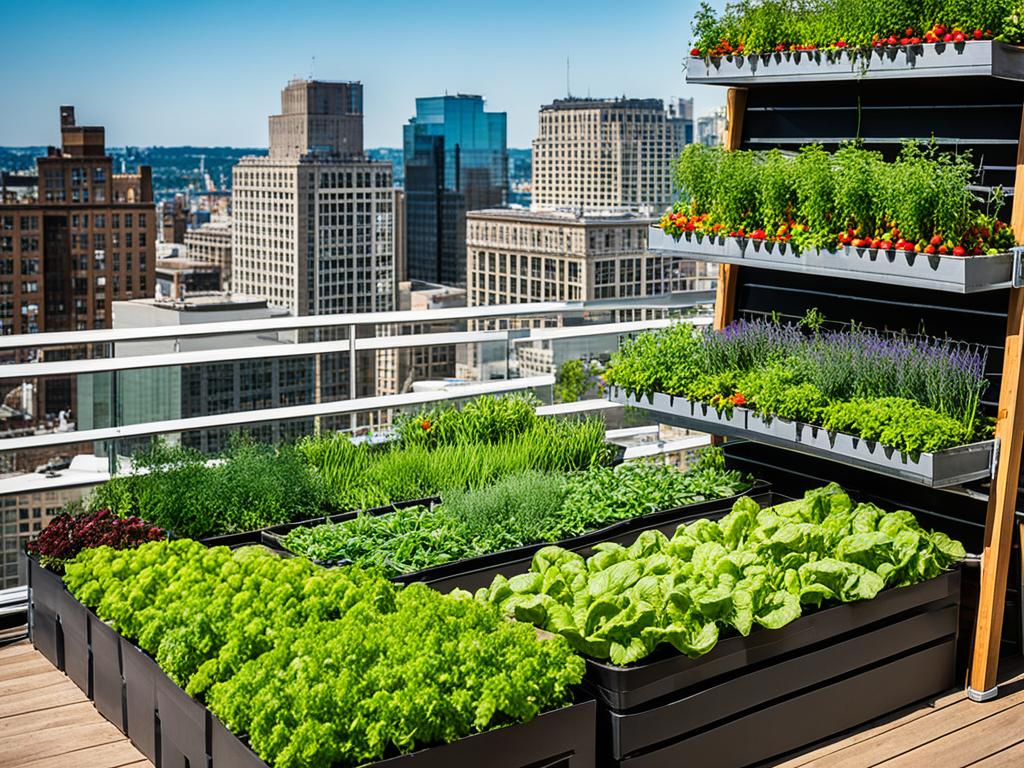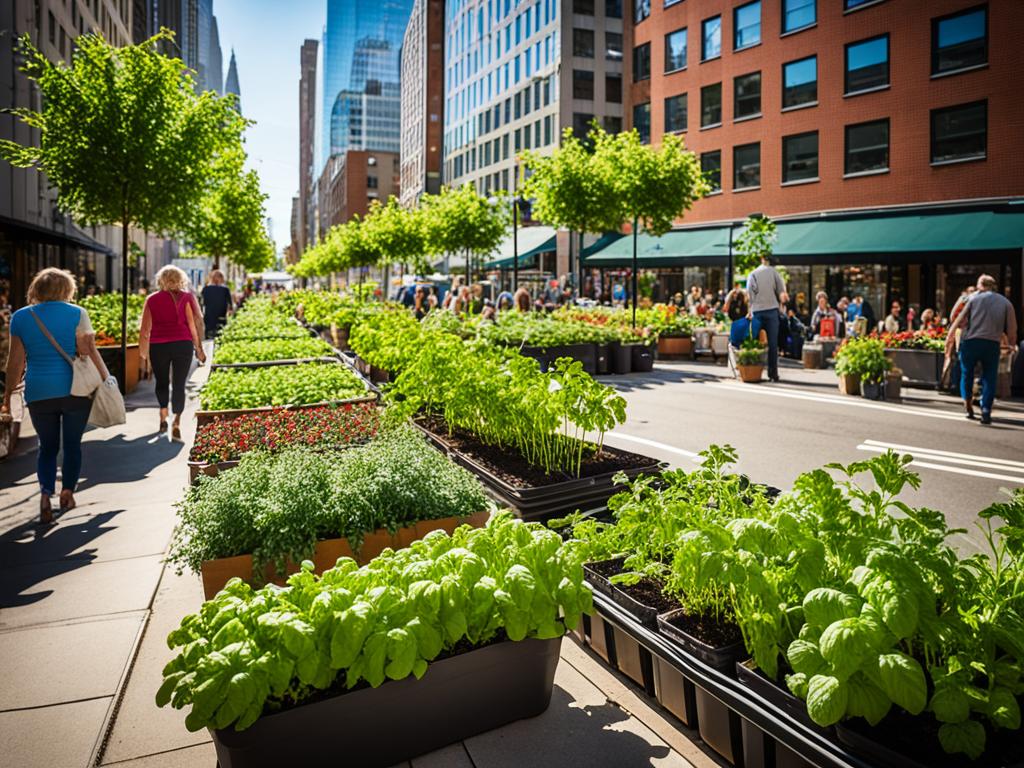Urban Gardening 101: Grow Veggies & Herbs
Welcome to urban gardening! If you have a small balcony, rooftop, or sunny windowsill, you can grow your own vegetables and herbs. Here, you’ll learn about the tools and supplies needed for your garden.
Necessary Tools and Supplies
To start a successful urban garden, you need the right tools and supplies. Here’s a list to check off:
- Containers: Choose pots, planters, or hanging baskets that fit your space. Make sure they are the right size and depth for your plants.
- Soil: Use a high-quality potting mix or make your own with garden soil, compost, and organic matter. Healthy soil is key for your plants’ growth and production.
- Seeds or Seedlings: Decide if you want to start from seeds or buy young plants (seedlings) from a nursery. Learn which vegetables and herbs do well in cities.
- Watering System: You might need a watering can, hose, or drip system for your garden’s size. It’s important to keep your plants hydrated, especially in the summer.
- Hand Tools: A set of gardening tools, like a trowel, pruners, and gloves, will make planting and caring for your garden easier.
- Fertilizer: Use organic fertilizers to give your plants essential nutrients. This helps them grow strong and healthy.
Now that you have the must-have tools and supplies, it’s time to plan your garden. Think about your space and what you want to grow. Consider the sunlight the area gets and if it’s good for plants.
Urban gardening lets you grow fresh food and enjoy the pride of growing it yourself. It’s also a green way to live and be healthier.
“Urban gardening lets us reconnect with nature and get fresh, local vegetables and herbs.” – John Smith, Urban Gardening Enthusiast
| Advantages of Urban Gardening | Challenges of Urban Gardening |
|---|---|
|
|
Best Vegetables and Herbs for Urban Gardens
Choosing the right vegetables and herbs is critical for a successful urban garden. Not all plants do well in the city’s limited spaces. So, it’s vital to pick varieties suited for urban growth. Let’s look at the top choices for urban gardens.
Compact Varieties
Urban gardens often have limited space, making compact plants a great choice. These specially bred varieties are perfect for small containers. They are also ideal for balconies, rooftops, and windowsills. Consider planting cherry tomatoes, miniature bell peppers, bush beans, and dwarf carrots for a great harvest.
These plants not only save space but also offer delicious and healthy food.
Vertical Gardening Techniques
Vertical gardening helps you use every inch of your urban garden. You can grow vegetables and herbs up high using trellises, arbors, and hanging baskets. Not only does it save on ground space, but it also looks beautiful. Try cucumbers, pole beans, vertical strawberries, and herbs like basil, rosemary, and mint for a thriving garden.
It also increases the amount of food you can grow.
Plants that Thrive in Urban Conditions
City environments often challenge plant growth with limited light and pollution. But, some plants excel in these conditions. For instance, “Citygreen” cherry tomatoes resist diseases and thrive in little sunlight.
Other plants like spinach, lettuce, thyme, and oregano do well in containers or small garden spaces.
| Vegetable | Urban Growing Tips |
|---|---|
| Cherry tomatoes | – Choose compact varieties for smaller spaces – Provide support for growing vines – Place in a sunny spot |
| Spinach | – Plant in well-draining soil – Harvest outer leaves for continuous growth – Protect from extreme heat |
| Basil | – Pinch off flower buds for prolonged growth – Regularly water to maintain soil moisture – Harvest leaves regularly to encourage bushier growth |
By choosing the right plants, you can make the most of your urban space. Enjoy growing a variety of fresh and tasty produce at home.
Vertical Gardening and Small Space Techniques

Urban gardening is full of unique challenges and cool opportunities. If space is tight, there are tricks to help you. You can use vertical and container gardening to grow veggies and herbs in every inch of your place.
Benefits of Vertical Gardening
Vertical gardening is loved by many in the city. It lets you grow plants up high. This way, you use every bit of space. Plus, it looks amazing. Growing up means more room for plants, less pests, and easy picking.
There are many ways to do vertical gardening. You can use things like trellises, lattices, or stakes for climbing plants. Hanging baskets or planters are great for herbs and lettuces. They cover walls and balconies with green, making any spot a garden.
Container Gardening for Limited Spaces
For those with small spaces, container gardening is perfect. It means planting in pots, boxes, or beds. You can garden on balconies, rooftops, or any small spot. Plus, you can move your plants around for the best sun and avoid bad weather.
Choosing the right containers is key. Pick ones that are light and strong, like plastic or fabric. Make sure they can drain water well. Also, match the pot size to your plants. Bigger plants need more room for their roots.
Utilizing Small Spaces Effectively
In the city, using all your space is important. Tools like wall planters, hanging gardens, and shelves can help. They not only save space but also look good.
Don’t limit yourself to the ground for planting. Window boxes, railings, or even stairs can become gardens. Using these spots means more room for growing all sorts of plants.
Essential Care for Urban Gardens
After setting up your urban garden with veggies and herbs, caring for them is crucial. Proper care ensures they grow well and give you tasty food. These care tips will help your garden thrive and provide a good harvest.
Watering:
For urban gardens, watering is key. Because plants in pots dry out fast, they need extra watering. Check the soil’s top inch daily; if it’s dry, water. But don’t water too much to avoid root rot. Drip systems or self-watering pots can make this task simpler.
Fertilizing:
Vegetables and herbs need regular fertilizing for proper nutrients. Use organic fertilizers or compost. Follow the fertilizer’s instructions for how and when to use it. Adding mulch around your plants keeps moisture, stops weeds, and provides extra nutrients over time.
Pest Management:
Urban gardens can attract pests like aphids, slugs, and snails. Always check your plants for pest damage. Use methods like companion planting to keep pests away or attract helpful bugs. Organic pest sprays and plant netting can also shield your garden from harm.
Crop Rotation:
Rotating crops yearly prevents the soil from losing nutrients and keeps the garden healthy. By moving your plants, you avoid many plant health problems. Use a simple plan that rotates plants in a three- to four-year cycle. This method keeps the garden productive.
Harvesting:
Knowing when to harvest is key to good flavor and quality. Pick leafy greens and herbs as they mature, starting from the outside. For fruits and roots, choose them when fully grown by giving a gentle pull. Harvesting regularly keeps plants producing.
Follow these practices to get the best from your urban garden. With more care experience, you’ll learn what your plants need. Enjoy the pleasure of urban gardening by eating the amazing food you’ve grown!
| Essential Care Tips for Urban Gardens |
|---|
| Watering |
| Fertilizing |
| Pest Management |
| Crop Rotation |
| Harvesting |
Conclusion
Urban gardening allows people to grow vegetables and herbs in the city. By using the advice in this article, beginners can start their own garden. They can then enjoy fresh, homegrown food.
From small city gardens to vertical projects, urban gardening is for everyone. It lets people be close to nature and supports green living. This way, anyone can have tasty, healthy meals grown in their own home.
Today, more people are interested in urban gardening. With the right planning and effort, anyone can have a city garden. They will love the flavor and satisfaction that comes from growing their food.
Getting into city gardening is not just good for you. It also helps make the city more beautiful and green. So, start your city garden today. Experience the happiness of seeing your own plants grow in the city.




